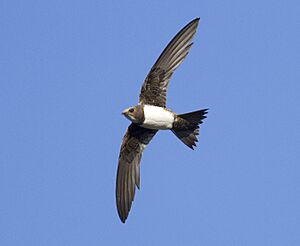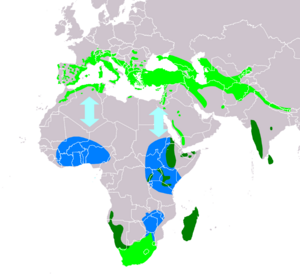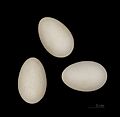Alpine swift facts for kids
Quick facts for kids Alpine swift |
|
|---|---|
 |
|
| Flying in Attica | |
| Conservation status | |
| Scientific classification | |
| Genus: |
Tachymarptis
|
| Species: |
melba
|
 |
|
| Range of T. melba Breeding Resident Non-breeding Vagrant (seasonality uncertain) Possibly Extant (passage) | |
| Synonyms | |
|
|
The alpine swift (Tachymarptis melba) is an amazing bird found in Africa, southern Europe, and Asia. These birds are known for spending most of their lives flying high in the sky. They are related to other swifts, but they are much larger. Alpine swifts breed in mountains from southern Europe all the way to the Himalayas.
Like many birds, they are migratory. This means they travel long distances. For example, the swifts from southern Europe fly south to southern Africa for the winter. They have very short legs, which they use to cling to vertical surfaces like cliffs. Swifts almost never land on the ground. They catch all their food, which is insects, while flying.
Contents
What's in a Name?
The scientific name for the alpine swift is Tachymarptis melba. The first part, Tachymarptis, comes from ancient Greek words. Takhus means "fast", and marptis means "seizer". So, it's like "fast seizer"! This name fits because they are super-fast at catching insects in the air. The second part, melba, refers to the two main colors Linnaeus saw when he first described the bird: black and white.
Meet the Alpine Swift!
How Big Are They?
Alpine swifts are quite large for a swift. They measure about 20–22 centimeters (8-9 inches) long. Their wingspan can reach an impressive 54–60 centimeters (21-24 inches)! That's almost two feet wide. They have broad wings and a tail that looks a bit like a shallow fork.
What Do They Look Like?
Their upper parts are olive-brown. Their wing-tips often look blacker. Underneath, they have a white throat and a very clear oval white patch on their belly. This white patch is surrounded by an olive-brown band across their chest and sides. Young alpine swifts look similar to adults. However, their feathers have pale edges.
Where Do They Live and Travel?
Alpine swifts breed in mountains from southern Europe to the Himalayas. They are strong migratory birds. They spend their winters much further south in southern Africa. They travel widely during migration. You can often see them in southern Europe, the Middle East, and Asia.
Scientists have found evidence that alpine swifts were much more widespread during the last ice age. For example, a large group lived in a cave in Bulgaria about 18,000–40,000 years ago.
Nesting and Family Life
These birds build their nests in groups, called colonies. They choose suitable cliff holes or caves. Female swifts usually lay two or three eggs. Swifts are loyal birds. They often return to the same nesting spots year after year. They will also rebuild their nests if needed. Alpine swifts usually pair for life.
Young swifts in the nest have a special trick. If the weather is bad and their parents can't find insects, the young birds can lower their body temperature. This helps them save energy until food is available again.
Alpine swifts have adapted well to living near people. They often nest in old buildings in towns around the Mediterranean Sea. Large groups flying low are a common sight there in summer.
Their Amazing Flight
Alpine swifts have a short, forked tail. Their wings are very long and swept back. They can look like a crescent moon or even a boomerang when flying. Sometimes, as in the image, they hold their wings stretched straight out. Their flight is slower and more powerful than that of smaller swifts. Their call is a long, drawn-out twittering sound.
Where in the World Do They Live?
Alpine swifts are found all year round in eastern and southern Africa, Madagascar, western India, and Sri Lanka. During the non-breeding season, they spread out even more. They can be found in western, eastern, and southern Africa, parts of the Arabian Peninsula, and across southern Europe. They also live in Turkey, the Caucasus region, and Central Asia. You can find them as far east as the Himalayas.
They usually breed in mountains below 1,500 meters (about 4,900 feet). However, they can sometimes go up to 2,300 meters (about 7,500 feet). In tropical areas like Kenya, they have been seen breeding above 4,000 meters (about 13,000 feet)!
How Do They Live?
Incredible Flight Abilities
Alpine swifts have a powerful and fast flight. Their wing beats are deep and slow. They are known for something called "twilight ascent." This means they fly higher and for longer distances at dawn and dusk. This might be how they interact with each other.
Alpine swifts spend most of their lives in the air. They catch insects to eat while flying. They even drink water while flying! They only land on vertical cliffs or walls to rest. A study in 2013 showed something amazing: Alpine swifts can fly for over six months without landing! This means they can do all their important body functions, including sleeping, while in the air. In 2011, scientists attached tiny trackers to six alpine swifts. They found that these birds could stay in the air for more than 200 days straight!
What Do They Eat?
The alpine swift's diet is mainly made up of arthropods. These are mostly insects, but they also eat spiders. Scientists have found over 79 different types of insects and spiders in the diets of alpine swifts. They mostly eat insects like homoptera (like aphids), diptera (flies), and hymenoptera (like bees and wasps).
Images for kids



